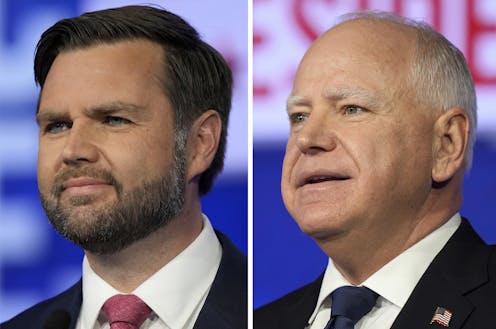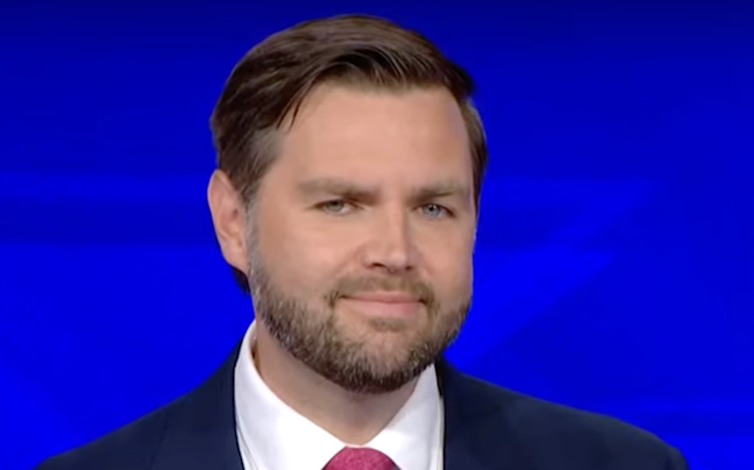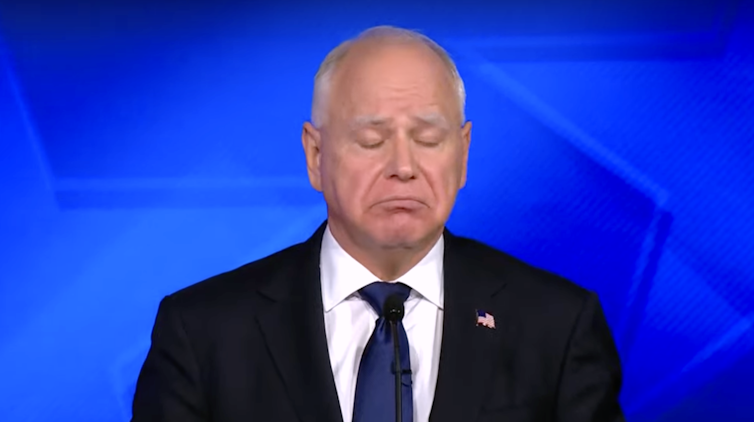
Neither Ohio GOP Sen. JD Vance nor Minnesota Democratic Gov. Tim Walz has the national stature of Vice President Kamala Harris and former President Donald Trump, so viewers had a chance to judge these two relatively unknown politicians for the first time, side by side, in a relatively uncontrolled setting on Oct. 1, 2024.
A lot of the post-debate analysis has centered on the candidates’ responses to questions on abortion and immigration, as well as other contentious issues like Trump’s and Vance’s refusal to recognize President Joe Biden’s 2020 win as legitimate.
But I didn’t listen too closely to what Vance and Walz said. Instead, I focused on their gestures, blinks and smiles. That’s because for over two decades I’ve researched the nonverbal behavior of political figures.
My research has long centered on the Swiss Army knife of facial behaviors: the smile. A smile isn’t just a sign of being happy. There are countless types of smiles, each of which has a distinct social purpose.
At their core, smiles are emotionally contagious – used as a sign to reassure others that we mean no harm and want to cooperate.
The types of smiles that politicians tend to display can give us insights into their personalities. Former President Ronald Reagan, who was known as the “Happy Warrior,” had a smile that was highly contagious and reassuring to both followers and opponents alike.
However, smiles can also be deployed as a form of self-regulation. And they can signal dominance, confidence and contempt.
Walz tries to shake off his nerves
At the outset, it was obvious that Walz was stressed on the debate stage.
After Walz shook Vance’s hand ahead of the debate, Walz stood, waiting, and then flashed what’s called an “affiliative smile.” This involved pulling up his lip corners quickly before the smile vanished. This type of smile is usually under the control of the individual and is posed to indicate the intent to cooperate.
Walz then broke out into a reward smile, with a relaxed jaw, his teeth showing, and the muscles around his eyes contracted. Smiling in this manner during stressful moments can be used to lessen negative emotions while increasing positive ones – and it appears that this form of self-regulation was Walz’s goal.
Vance pleased with himself
While Vance was much less expressive than Walz, he did appear to show a slight smile after he attempted to bait Walz into defending the specifics of the 2023 Minnesota Reproductive Freedom Defense Act. Among other things, this law protects out-of-state patients traveling to Minnesota to get an abortion from criminal penalties and legal attacks.
Vance’s smile occurred just as viewers went to commercial break. Perhaps Vance was pleased with how he performed on an issue that has dogged his ticket – and was just grateful to be moving on.

Vance’s lack of expressiveness during the debate may be seen as standing in stark contrast to Trump’s larger-than-life persona. Perhaps that was the reason why Trump chose Vance as a running mate.
However, while Vance presented himself as calm, befitting his Ivy League legal education, the very slight movements of his face revealed little – and could lead to viewers having a hard time connecting with him emotionally as a potential leader.
Walz caught in a fib
One rather interesting moment – especially for viewers used to public figures telling bald-faced lies – wasn’t actually a smile.
Walz blushed in embarrassment after being caught in a fib regarding him being in Hong Kong during the 1989 Tiananmen Square massacre. He attempted to dodge the question, and when one of the moderators – Margaret Brennan – followed up, Walz owned up and said that he “misspoke.” Both Walz’s indirect answer and the redness of his face showed his feelings of embarrassment.
For most people, the pooling of the blood under the skin is an involuntary reaction to embarrassment. But it actually has the effect of making them seem more trustworthy because blushing reliably relates concern for others – and predicts attempts to make things better as a result. At the same time, Walz’s closed eyes and the pulling of his lip corners down while his lower lip was pushed up suggests a degree of disappointment in himself.

Most Americans already know who they will vote for, and few might have their minds changed by Vance’s and Walz’s debate performance. What might matter more is the candidates’ nonverbal behavior, and the insight this gives into how either of the candidates might behave in office. Facial behavior generally – and smiles more specifically – provide insights into personality traits, while body movement more generally is connected with charisma.
Regardless of who wins, it makes sense to pay attention not just to what candidates say, but also how they smile, sneer and scowl.
Patrick Stewart does not work for, consult, own shares in or receive funding from any company or organization that would benefit from this article, and has disclosed no relevant affiliations beyond their academic appointment.
This article was originally published on The Conversation. Read the original article.







